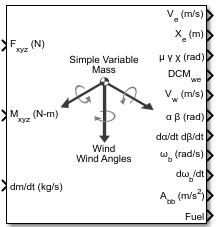Simple Variable Mass 6DOF Wind (Wind Angles)
Implement wind angle representation of six-degrees-of-freedom equations of motion of simple variable mass
Libraries:
Aerospace Blockset /
Equations of Motion /
6DOF
Description
The Simple Variable Mass 6DOF Wind (Wind Angles) block implements a wind angle representation of six-degrees-of-freedom equations of motion of simple variable mass. For more information of the relationship between the wind angles, see Algorithms. For a description of the coordinate system employed and the translational dynamics, see the block description for the Simple Variable Mass 6DOF (Quaternion) block.
Limitations
The block assumes that the applied forces are acting at the center of gravity of the body.
Ports
Input
Output
Parameters
Algorithms
The relationship between the wind angles, []T, can be determined by resolving the wind rates into the wind-fixed coordinate frame.
Inverting J then gives the required relationship to determine the wind rate vector.
The body-fixed angular rates are related to the wind-fixed angular rate by the following equation.
Using this relationship in the wind rate vector equations, gives the relationship between the wind rate vector and the body-fixed angular rates.
References
[1] Stevens, Brian, and Frank Lewis. Aircraft Control and Simulation, 2nd ed. Hoboken, NJ: John Wiley & Sons, 2003.
[2] Zipfel, Peter H. Modeling and Simulation of Aerospace Vehicle Dynamics. 2nd ed. Reston, VA: AIAA Education Series, 2007.
Extended Capabilities
Version History
Introduced in R2006a
See Also
6DOF (Euler Angles) | 6DOF (Quaternion) | 6DOF ECEF (Quaternion) | 6DOF Wind (Quaternion) | 6DOF Wind (Wind Angles) | Custom Variable Mass 6DOF (Euler Angles) | Custom Variable Mass 6DOF (Quaternion) | Custom Variable Mass 6DOF ECEF (Quaternion) | Custom Variable Mass 6DOF Wind (Quaternion) | Custom Variable Mass 6DOF Wind (Wind Angles) | Simple Variable Mass 6DOF ECEF (Quaternion) | Simple Variable Mass 6DOF (Euler Angles) | Simple Variable Mass 6DOF (Quaternion) | Simple Variable Mass 6DOF Wind (Quaternion)
